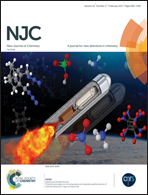Mixed-ligand copper(ii) Schiff base complexes: the vital role of co-ligands in DNA/protein interactions and cytotoxicity†
Abstract
A series of four new mixed-ligand copper(II) complexes (1–4) of the type [Cu(L)(diimine)] (ClO4) [where L is 2-((1H-imidazol-2-yl)methylene)-N-phenylhydrazinecarbothioamide and the diimines are 1,10-phenanthroline (phen, 1), 2,2′-bipyridine (bpy, 2), 4,4′-dimethyl-2,2′-bipyridyl (dmbpy, 3), and 2,2′-dipyridylamine (dpa, 4)] have been successfully synthesized and characterized by various spectral techniques. The Kb values were calculated from electronic absorption spectral titration of these complexes with herring sperm DNA, and these varied in the order phen (1) > dmbpy (3) > bpy (2) > dpa (4). Electrophoresis observations revealed that these complexes (1–4) could efficiently induce single-strand breakage of pUC18 plasmid DNA in the presence of ascorbic acid. These copper complexes underwent a static quenching process with BSA. Moreover, their potential free-radical scavenging and anti-inflammatory properties were also determined using DPPH and protein denaturation techniques. These complexes showed efficient antibacterial activities against Staphylococcus aureus (Gram positive) and Pseudomonas aeruginosa (Gram negative). Furthermore, studies of their in vitro cytotoxicity against AGS cancer cells indicated promising antitumor activity with significant IC50 values.



 Please wait while we load your content...
Please wait while we load your content...